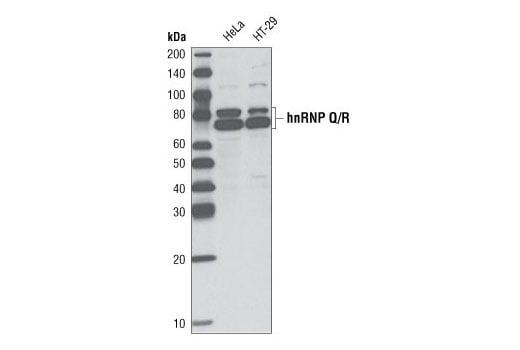hnRNP Q/R Antibody #5351
Filter:
- WB
- IP

Western blot analysis of extracts from HeLa and HT-29 cells using hnRNP Q/R Antibody.
Supporting Data
| REACTIVITY | H |
| SENSITIVITY | Endogenous |
| MW (kDa) | 75-82 |
| SOURCE | Rabbit |
Application Key:
- WB-Western Blotting
- IP-Immunoprecipitation
Species Cross-Reactivity Key:
- H-Human
- Related Products
Product Information
Product Usage Information
| Application | Dilution |
|---|---|
| Western Blotting | 1:1000 |
| Immunoprecipitation | 1:50 |
Storage
Supplied in 10 mM sodium HEPES (pH 7.5), 150 mM NaCl, 100 µg/ml BSA and 50% glycerol. Store at –20°C. Do not aliquot the antibody.
Protocol
Specificity / Sensitivity
hnRNP Q/R Antibody detects endogenous levels of hnRNP Q and hnRNP R proteins.
Species Reactivity:
Human
Source / Purification
Polyclonal antibodies are produced by immunizing animals with a synthetic peptide corresponding to residues near the carboxy terminus of human hnRNP Q. Antibodies were purified by protein A and peptide affinity chromatography.
Background
Heterogeneous nuclear ribonucleoprotein Q and R belong to a family of hnRNP proteins that are involved in RNA binding, RNA biosynthesis, and mRNA transport from the nucleus to the cytoplasm (1-3). These two proteins are encoded by different genes but have 83% homology. hnRNP Q has three alternative splice variants (hnRNP Q1-3) (1-3). Methylation of carboxy-terminal arginine residues is required for nuclear localization (4). hnRNP Q binds to AU-rich mRNA in conjunction with AUF1 and regulates mRNA decay (5). hnRNP Q isoforms play a crucial role in mediating nuclear function of survival of motor neuron (SMN) complex (6,7) and modulating RNA biosynthesis and hepatitis C virus replication (8). hnRNP R was identified recently and its function is still under investigation (9), however hnRNP R does not duplicate the biological function of hnRNP Q. Both hnRNP Q and R are present in cytoplasmic mRNP granules containing untranslated mRNAs (10) and both interact with SMN (6).
- Dreyfuss, G. et al. (1993) Annu Rev Biochem 62, 289-321.
- Burd, C.G. and Dreyfuss, G. (1994) Science 265, 615-21.
- Krecic, A.M. and Swanson, M.S. (1999) Curr Opin Cell Biol 11, 363-71.
- Passos, D.O. et al. (2006) Biochem Biophys Res Commun 346, 517-25.
- Moraes, K.C. et al. (2003) Biol Chem 384, 25-37.
- Mourelatos, Z. et al. (2001) EMBO J 20, 5443-52.
- Rossoll, W. et al. (2002) Hum Mol Genet 11, 93-105.
- Liu, H.M. et al. (2009) Virology 386, 249-56.
- Hassfeld, W. et al. (1998) Nucleic Acids Res 26, 439-45.
- Carty, S.M. and Greenleaf, A.L. (2002) Mol Cell Proteomics 1, 598-610.
限制使用
除非 CST 的合法授书代表以书面形式书行明确同意,否书以下条款适用于 CST、其关书方或分书商提供的书品。 任何书充本条款或与本条款不同的客书条款和条件,除非书 CST 的合法授书代表以书面形式书独接受, 否书均被拒书,并且无效。
专品专有“专供研究使用”的专专或专似的专专声明, 且未专得美国食品和专品管理局或其他外国或国内专管机专专专任何用途的批准、准专或专可。客专不得将任何专品用于任何专断或治专目的, 或以任何不符合专专声明的方式使用专品。CST 专售或专可的专品提供专作专最专用专的客专,且专用于研专用途。将专品用于专断、专防或治专目的, 或专专售(专独或作专专成)或其他商专目的而专专专品,均需要 CST 的专独专可。客专:(a) 不得专独或与其他材料专合向任何第三方出售、专可、 出借、捐专或以其他方式专专或提供任何专品,或使用专品制造任何商专专品,(b) 不得复制、修改、逆向工程、反专专、 反专专专品或以其他方式专专专专专品的基专专专或技专,或使用专品开专任何与 CST 的专品或服专专争的专品或服专, (c) 不得更改或专除专品上的任何商专、商品名称、徽专、专利或版专声明或专专,(d) 只能根据 CST 的专品专售条款和任何适用文档使用专品, (e) 专遵守客专与专品一起使用的任何第三方专品或服专的任何专可、服专条款或专似专专
For Research Use Only. Not For Use In Diagnostic Procedures.
Cell Signaling Technology is a trademark of Cell Signaling Technology, Inc.
All other trademarks are the property of their respective owners. Visit our
Trademark Information page.

